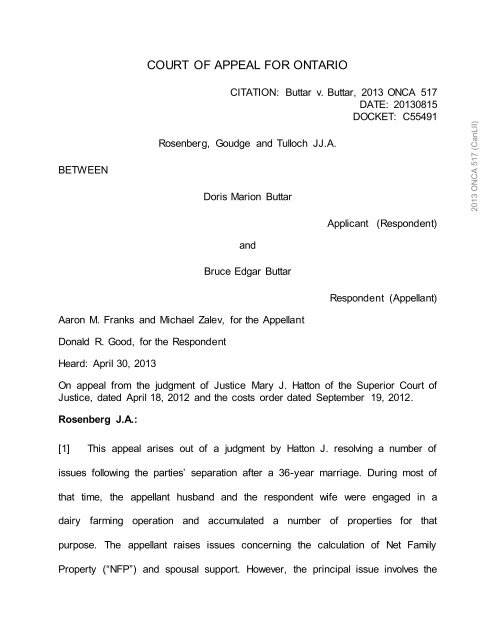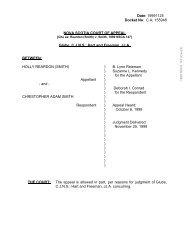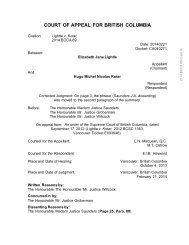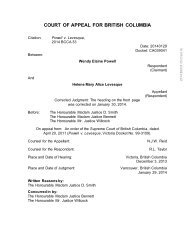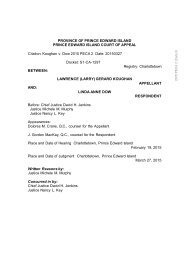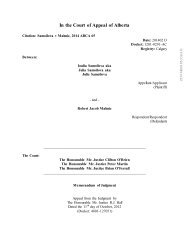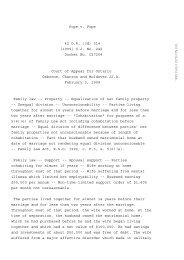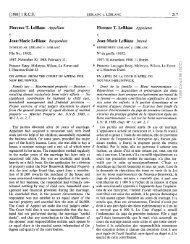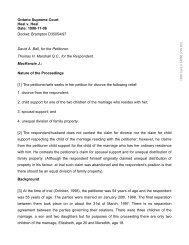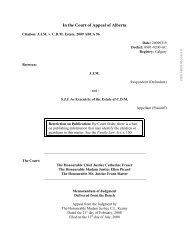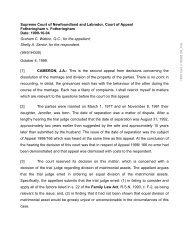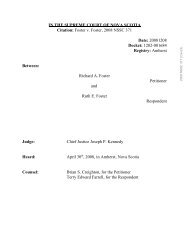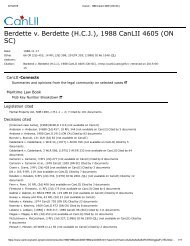Buttar v Buttar 2013onca517
Buttar v Buttar 2013onca517
Buttar v Buttar 2013onca517
You also want an ePaper? Increase the reach of your titles
YUMPU automatically turns print PDFs into web optimized ePapers that Google loves.
BETWEEN<br />
COURT OF APPEAL FOR ONTARIO<br />
CITATION: <strong>Buttar</strong> v. <strong>Buttar</strong>, 2013 ONCA 517<br />
DATE: 20130815<br />
DOCKET: C55491<br />
Rosenberg, Goudge and Tulloch JJ.A.<br />
Doris Marion <strong>Buttar</strong><br />
and<br />
Bruce Edgar <strong>Buttar</strong><br />
Applicant (Respondent)<br />
2013 ONCA 517 (CanLII)<br />
Respondent (Appellant)<br />
Aaron M. Franks and Michael Zalev, for the Appellant<br />
Donald R. Good, for the Respondent<br />
Heard: April 30, 2013<br />
On appeal from the judgment of Justice Mary J. Hatton of the Superior Court of<br />
Justice, dated April 18, 2012 and the costs order dated September 19, 2012.<br />
Rosenberg J.A.:<br />
[1] This appeal arises out of a judgment by Hatton J. resolving a number of<br />
issues following the parties’ separation after a 36-year marriage. During most of<br />
that time, the appellant husband and the respondent wife were engaged in a<br />
dairy farming operation and accumulated a number of properties for that<br />
purpose. The appellant raises issues concerning the calculation of Net Family<br />
Property (“NFP”) and spousal support. However, the principal issue involves the
Page: 2<br />
application judge’s order dividing the six jointly-owned farm properties between<br />
the appellant and the respondent in satisfaction of the equalization and spousal<br />
support payments. .<br />
[2] For the following reasons, I would allow the appeal in part, and set aside<br />
the order distributing the properties between the parties. I would allow the<br />
appellant to deduct his disposition costs from his NFP, but I would dismiss his<br />
2013 ONCA 517 (CanLII)<br />
appeal as it relates to the exclusion of the milk quota from his NFP and the<br />
payment of spousal support.<br />
A. THE FACTS<br />
[3] The following summary sets out this family’s history and the history of the<br />
acquisition of the jointly held properties.<br />
[4] The appellant and respondent married in 1972 and separated in 2008.<br />
They have three adult children. The appellant’s parents were farmers. After the<br />
parties, who had met in college, graduated, the appellant began to work on the<br />
farm with his father, although he also held another job. The respondent worked<br />
as a teacher. In 1973, the parties built a house on the Donaldson Road property<br />
that was owned by the appellant’s parents. In 1976, the appellant started farming<br />
full-time. Two years later, the appellant’s parents gave the parties the Donaldson<br />
Road property.
Page: 3<br />
[5] In 1979, the appellant’s parents transferred ownership and control of their<br />
farming business to their son and his wife. As part of the transaction, the<br />
Home/Main farm, including its properties, was gifted to the appellant and the<br />
respondent jointly. 5,970 kg of milk quota and equipment were gifted to the<br />
appellant alone. The livestock was sold to the appellant for $55,000. The transfer<br />
was structured so as to minimize income tax consequences. Particularly, by<br />
2013 ONCA 517 (CanLII)<br />
structuring the milk quota part of the disposition of the farm as a gift to his son,<br />
the appellant’s father was able to avoid tax consequences in accordance with<br />
s. 73 of the Income Tax Act, R.S.C. 1985, c. 1 (5th Supp). The Dairy Farmers of<br />
Ontario confirmed that there was no selling price listed on the application to<br />
transfer the quota.<br />
[6] In 1980, the appellant started farming with his cousin David. He and David<br />
purchased the Watt farm. The joint farming operation continued until 1988. At<br />
that time, the appellant and David divided their milk quota and the appellant<br />
purchased some of David’s quota, leaving the appellant with 8,785 kg. of quota.<br />
In the meantime, the parties and their children had moved into the Home/Main<br />
Farm and the appellant’s parents had moved into the Donaldson Road Property.<br />
[7] In 2002, the parties purchased another farm, the Blezard Farm. In 2004,<br />
they purchased David’s interest in the Watt farm. In 2007, they purchased<br />
David’s Farm. Finally, at some point the parties also purchased the School Farm.
Page: 4<br />
[8] Thus, at the time of separation, the parties jointly owned six properties:<br />
The Home\Main Farm;<br />
The Donaldson Road property, which is comprised of two severed lots;<br />
The Watt Farm;<br />
The Blezard Farm, which is also comprised of two lots;<br />
David’s Farm, and<br />
2013 ONCA 517 (CanLII)<br />
The School Farm<br />
[9] The parties also jointly held a time-share interest in a Collingwood<br />
property, which was also transferred as part of the trial judge’s order.<br />
[10] In the 1990’s, the parties began a series of improvements to the family<br />
farm business and borrowed heavily from Farm Credit Canada to finance the<br />
improvements. At the date of separation, the gross value of the farm properties<br />
was $2,330,000 and the jointly owed debt to Farm Credit Canada was<br />
$1,411,574.00. The appellant also owned 27,561 kg of milk quota with a value of<br />
$1,867,572.30 (before capital gains tax) and farm equipment and cattle with a<br />
value of $370,072.12 (before capital gains tax). The parties had other assets as<br />
follows: the appellant, $74,269.16; the respondent $56,594.<br />
[11] After the separation, the parties and their children conducted some<br />
negotiations about what to do with the dairy operation. The parties have different<br />
views as to why those negotiations failed. In the event, the appellant sold the
Page: 5<br />
dairy quota in two lots in early 2010 for $1,867,572.30, which he used to pay off<br />
the FCC debt. The balance of $358,253.46 was paid into the respondent’s<br />
lawyer’s trust account. These funds were eventually disbursed by agreement<br />
between the parties. Later in 2010, the appellant sold the dairy herd and farm<br />
equipment. He used some of this money to purchase other equipment, including<br />
farm machinery and a tractor trailer. As a result of the various sales, the<br />
2013 ONCA 517 (CanLII)<br />
appellant incurred $280,000 in capital gains taxes after using his $750,000<br />
lifetime capital gains exemption.<br />
[12] At the time of application, the respondent was 65 years of age and the<br />
appellant was 62 years of age. During the marriage, the respondent held a<br />
number of jobs to supplement the farm income. She also assisted with the dairy<br />
operation until it was sold in early 2010. During the last years of the marriage, the<br />
respondent had only sporadic employment with a local service club. Thus, from<br />
2007 to 2009, she earned less than $3,000 a year. In 1989, the respondent was<br />
diagnosed with breast cancer. A second cancer diagnosis was made in 2006. As<br />
a result of the cancer and subsequent treatment the respondent has difficulty<br />
with heavy manual labour.<br />
[13] The farm business was successful. The income was reported on the<br />
appellant’s tax return and reached almost $900,000 in 2010. After the dairy<br />
operation ended, the appellant derived income from various jobs. He expected<br />
his annual income to be less than $20,000. The appellant paid spousal support of
Page: 6<br />
$2,000 per month from the date of separation to February 2010, when the dairy<br />
operation ceased. He had not paid any spousal support since that time.<br />
B. THE ISSUES<br />
[14] By the time of the application, many financial issues had been settled. The<br />
application judge dealt with six issues, four of which remain issues on this appeal<br />
as follows:<br />
2013 ONCA 517 (CanLII)<br />
1. Whether the appellant can deduct from his NFP the<br />
present value of the disposition costs, and in particular<br />
the capital gains tax, that he will incur upon sale of the<br />
properties.<br />
2. Whether the appellant can exclude from his NFP the<br />
milk quota his father gave him in 1979.<br />
3. How much spousal support is owed to the<br />
respondent.<br />
4. Whether, and if so how, the jointly-owned properties<br />
should be distributed.<br />
ISSUE 1: DISPOSITION COSTS<br />
(1) The Reasons of the Application Judge<br />
[15] The appellant claimed that, in calculating his NFP, he was entitled to claim<br />
as a debt any capital gains he would incur after using his $750,000 lifetime<br />
exemption. The application judge allowed the appellant to claim as a debt the<br />
capital gains already incurred at the time of the application. She did not,<br />
however, allow him to claim the expected capital gains tax liability that would
Page: 7<br />
arise from the proposed sale of all the farm properties. The appellant sought to<br />
claim $270,000.<br />
[16] The application judge concluded that the sale of the properties was not<br />
inevitable. Her reasoning was related to her ultimate conclusion that each party<br />
would be given specific property as a result of the judgment in this case. She<br />
speculated that the parties, in deciding what to do with the properties respectively<br />
2013 ONCA 517 (CanLII)<br />
allotted to them, might choose to retain the properties or transfer them to their<br />
children. She therefore held that neither party would be given a capital gains<br />
deduction for the future sale of any property, and that each would individually<br />
bear the costs of any capital gains tax incurred on future dispositions. It should<br />
be pointed out that this would not be a serious hardship for the respondent, since<br />
she still had her lifetime capital gains tax exemption available to her.<br />
(2) Analysis<br />
[17] In my view, the application judge erred in not permitting the appellant to<br />
treat as a debt under s. 4(1) of the Family Law Act, R.S.O. 1990, c. F.3 (“the<br />
Act”) the capital gains taxes he would incur on the proposed sale of the<br />
properties. There are a couple of reasons for this, including, as will be discussed<br />
below, that the appropriate order in this case would have been to order the sale<br />
of the properties in question. Once sold, the disposition costs would be<br />
inevitable.
Page: 8<br />
[18] Quite apart from the appropriateness of an order for sale in this case, the<br />
application judge erred in law in refusing to allow the capital gains tax as a cost<br />
of disposition.<br />
[19] The test for deducting disposition costs from NFP as set out in<br />
Sengmueller v. Sengueller (1994), 17 O.R. (3d) 208 (C.A.), at pp. 213, is as<br />
follows:<br />
2013 ONCA 517 (CanLII)<br />
In my view, it is equally appropriate to take such costs<br />
into account in determining net family property under<br />
the Family Law Act if there is satisfactory evidence of a<br />
likely disposition date and if it is clear that such costs<br />
will be inevitable when the owner disposes of the assets<br />
or is deemed to have disposed of them. In my view, for<br />
the purposes of determining net family property, any<br />
asset is worth (in money terms) only the amount which<br />
can be obtained on its realization, regardless of whether<br />
the accounting is done as a reduction in the value of the<br />
asset, or as deduction of a liability: the result is the<br />
same. While these costs are not liabilities in the balance<br />
sheet sense of the word, they are amounts which the<br />
owner will be obliged to satisfy at the time of disposition,<br />
and hence, are ultimate liabilities inextricably attached<br />
to the assets themselves. This is consistent with<br />
McPherson but goes beyond it. [Emphasis added.]<br />
[20] This court had, in the earlier case of Starkman v. Starkman (1990), 75<br />
O.R. (2d) 19 at pp. 23 and 26, adopted the approach from McPherson v.<br />
McPherson (1988), 63 O.R. 2(d) 641, as set out in the following passage from<br />
McPherson, at p. 647:<br />
... an allowance should be made in the case where<br />
there is evidence that the disposition will involve a sale<br />
or transfer of property that attracts tax consequences,
Page: 9<br />
and it should not be made in the case where it is not<br />
clear when, if ever, a sale or transfer of property will be<br />
made and thus the tax consequences of such an<br />
occurrence are so speculative that they can safely be<br />
ignored. [Emphasis added.]<br />
[21] The test used by the application judge is stricter than the tests in<br />
Sengmueller and McPherson. The application judge looked to whether the<br />
disposition of the assets was inevitable. Instead, she should have determined<br />
whether it was more likely than not that the assets would be sold, at which point<br />
2013 ONCA 517 (CanLII)<br />
disposition costs would inevitably be incurred.<br />
[22] Quite apart from the appropriateness of ordering the properties sold, the<br />
evidence established that the appellant would have to sell some of his property<br />
interests in order to pay the taxes he owed on the sale of equipment and to pay<br />
the costs order. At that point, the appellant would inevitably incur capital gains<br />
tax, inasmuch as he had already used up his lifetime exemption.<br />
[23] The NFP of the parties must be adjusted accordingly. Of course, the<br />
respondent will also be entitled to deduct her costs of disposition.<br />
ISSUE 2: THE 1979 MILK QUOTA<br />
(1) The Reasons of the Application Judge<br />
[24] At the application, the appellant sought to exclude from his NFP the value<br />
of the milk quota provided to him by his father in 1979 on the basis that it was a<br />
gift within the meaning of s. 4(2) of the Act, which provides as follows:
Page: 10<br />
4(2) The value of the following property that a spouse<br />
owns on the valuation date does not form part of the<br />
spouse's net family property:<br />
1. Property, other than a matrimonial home,<br />
that was acquired by gift or inheritance<br />
from a third person after the date of the<br />
marriage.<br />
[25] The application judge found that the milk quota was transferred in 1979 as<br />
part of a larger transaction involving the transfer of the family farm from the<br />
2013 ONCA 517 (CanLII)<br />
appellant’s parents to the parties. She found that the transfer was structured so<br />
as to minimize tax consequences. As a result of this transaction, both parties<br />
assumed all the liabilities associated with the transfer. The respondent shared<br />
equally in assuming the liabilities and paying the expenses of all the assets,<br />
including the milk quota.<br />
[26] The application judge found that the transfer of the milk quota was not a<br />
gift because there was consideration for the transfer. This consideration took the<br />
form of a life interest given to the appellant’s parents in the family farm. The<br />
father lived on the farm until his death, while the mother remained until she<br />
moved to a retirement home. As the application judge said:<br />
[The appellant’s parents] were both financially provided<br />
for by the parties for the rest of their lives from income<br />
generated by all the transferred assets, including the<br />
milk quota. The wife cared for both the husband’s<br />
parents until their deaths.<br />
[27] The application judge found that, in any event, the appellant had not<br />
shown that the quota that was transferred in 1979 was still in the appellant’s
Page: 11<br />
possession at the time of separation. The application judge referred to a history<br />
of sales and purchases of quotas over the years, and concluded that the quota<br />
ultimately sold in 2010 had been acquired through the combined efforts of both of<br />
the parties.<br />
(2) Analysis<br />
[28] The term “gift” is not defined in the Act. In McNamee v. McNamee, 2011<br />
2013 ONCA 517 (CanLII)<br />
ONCA 533, 106 O.R. (3d) 401, this court set out the elements of a gift in the<br />
following way, at para. 24:<br />
The essential ingredients of a legally valid gift are not in<br />
dispute. There must be (1) an intention to make a gift on<br />
the part of the donor, without consideration or<br />
expectation of remuneration, (2) an acceptance of the<br />
gift by the done, and (3) a sufficient act of delivery or<br />
transfer of the property to complete the transaction:<br />
Cochrane v. Moore, (1890), 25 Q.B.D. 57 (C.A.), at pp.<br />
72-73 Q.B.D.; Mossman and Flanagan, supra, at p. 441,<br />
Bruce Ziff, Principles of Property Law, 5th ed. (Toronto:<br />
Carswell, 2010), at p. 157.<br />
[29] In Peter v. Beblow, [1993] 1 S.C.R. 980, at pp. 991-92, McLachlin J.<br />
referred to giving without expectation of remuneration as the “central element of<br />
a gift at law”. The only element in dispute in this case is whether the appellant’s<br />
father intended to make a gift of the milk quota without consideration or<br />
expectation of remuneration.<br />
[30] In support of his argument that there was no consideration for the transfer,<br />
the appellant points to the following pieces of evidence, among others: that the
Page: 12<br />
appellant’s father followed the advice of his accountant to gift the quota at a<br />
deemed valued of ‘Nil’ to minimize income tax consequences at the time of the<br />
transfer; that the Dairy Farmers of Ontario confirmed “there was no selling price<br />
listed” on the quota transfer application, and that the appellant testified that he<br />
“did not pay anything for [the quota]”. The appellant also relies upon this court’s<br />
decision in McNamee and submits that the application judge focused on the<br />
2013 ONCA 517 (CanLII)<br />
motive for the transfer (deferring taxes) instead of the nature of the transaction.<br />
[31] In McNamee, the father executed a Declaration of Gift at the time he<br />
issued common shares to his sons, which included the appellant husband, as<br />
part of an estate freeze. The husband was not aware of the details of the estate<br />
freeze transaction. This court held that the trial judge in McNamee erred in<br />
finding that the transfer of the shares was not a gift. With respect to the trial<br />
judge’s finding that there was consideration for the transfer, this court explained,<br />
at para. 29, that consideration “is the value that flows from a promisee to a<br />
promisor as a result of a bargain. There can be no consideration, however, when<br />
there has been no bargain”. The court continued:<br />
[C]onsideration cannot flow from a promisee who does<br />
not know he or she is negotiating, much less passing<br />
value to a promisor in an exchange he or she doesn't<br />
know exists.<br />
[32] In that case, this court held that the share transfer was unilateral on the<br />
part of the appellant’s father, and that the sons had no meaningful input with
Page: 13<br />
respect to it. This court also held that the fact that the appellant’s father was able<br />
to accomplish his corporate planning goals did not amount to consideration<br />
flowing from his son to him.<br />
[33] The application judge’s statement that this case can be distinguished from<br />
McNamee because this was not an estate freeze is less helpful than her ultimate<br />
conclusion that the transfer was not a “true gift to the husband as there was<br />
2013 ONCA 517 (CanLII)<br />
consideration provided by both the husband and the wife”. That consideration<br />
consisted of the life interest in the family farm, the fact that the parents continued<br />
to live on the farm, that they were both financially provided for from income<br />
generated by the transferred assets, including the milk quota, and that the<br />
respondent cared for the parents until their death.<br />
[34] The application judge’s conclusion that the transfer of the milk quota to the<br />
appellant was not a true gift is based on findings of fact that are entitled to<br />
deference. The appellant is required to identify a palpable and overriding error:<br />
Housen v. Nikolaisen, 2002 SCC 33, [2002] 2 S.C.R. 235, at para. 10.<br />
[35] I have not been persuaded that the application judge erred. The<br />
application judge’s findings as to the nature of the arrangement between the<br />
parties and the appellant’s parents are supported by the evidence. The evidence<br />
shows that this appellant, unlike the husband in McNamee, was involved in the<br />
transaction. The milk quota was part of a much larger transaction for which there
Page: 14<br />
was consideration. The items identified by the application judge are capable of<br />
constituting consideration when the transfer of the milk quota transaction is<br />
placed within the context of the entire transaction and this family’s history. The<br />
application judge also did not improperly focus on the motive for the transaction.<br />
The application judge’s reasons show that she was properly concerned with the<br />
question whether or not there was any consideration for the 1979 transfer of the<br />
2013 ONCA 517 (CanLII)<br />
milk quota.<br />
[36] Finally, the appellant has not demonstrated that the fact the transaction<br />
may have been driven by tax advice was a basis for finding a gift. As the<br />
respondent points out the tax treatment of family farms is complex and it is not<br />
clear that this transaction was contrary to the public policy underlying the tax<br />
treatment of such farms. I would not give effect to this ground of appeal.<br />
ISSUE 3: SPOUSAL SUPPORT<br />
(1) The Reasons of the Application Judge<br />
[37] There was no dispute about the respondent’s entitlement to spousal<br />
support, although her need for it was disputed. At the application, the most<br />
contentious issues were the appellant’s actual income and the amount that<br />
should be imputed to him.<br />
[38] The appellant took the position that he was entitled to retire from farming<br />
and to work less for less money. The application judge found the appellant’s
Page: 15<br />
evidence as to his inability to earn a greater income to be questionable. He was<br />
an experienced farmer and had purchased farm machinery and a tractor trailer to<br />
generate income. He had no health problems and continued to incur substantial<br />
personal expenses. The application judge found that the appellant’s claimed<br />
drastic income reduction from an inferred income of between $60,000 to $80,000<br />
to less than $20,000 annually was neither reasonable nor credible. The<br />
2013 ONCA 517 (CanLII)<br />
application judge imputed to the appellant an annual income of $40,000.<br />
[39] The application judge also considered the respondent’s circumstances.<br />
This was a long-term marriage where the respondent was in a very vulnerable<br />
position because of her health and her limited ability to earn an income. While<br />
the appellant had paid other expenses, he had paid no spousal support since<br />
February 2010. On the other hand, the application judge stated that the<br />
respondent would have some income, either from the sale of the properties or by<br />
renting them out. This last appears to relate to the application judge’s ultimate<br />
decision to divide the jointly-held properties between the parties.<br />
[40] The application judge determined that the respondent would be entitled to<br />
indefinite spousal support, given her age and the fact that this was a long-term<br />
marriage, but instead ordered a lump sum payment. She considered the Spousal<br />
Support Advisory Guidelines and made an award around the midpoint. The<br />
application judge ordered the appellant to make a lump sum payment of
Page: 16<br />
$160,000 for spousal support. The application judge did not expressly state why<br />
the spousal support should be a lump sum rather than periodic payments.<br />
(2) Analysis<br />
[41] The appellant does not contest the application judge’s decision to order a<br />
lump sum spousal support award. He does, however, take issue with the amount<br />
awarded. He submits that the application judge erred in failing to consider the<br />
2013 ONCA 517 (CanLII)<br />
respondent’s significant capital base, erred in imputing an excessive amount of<br />
employment income and erred in calculating the lump sum on the basis of<br />
indefinite support. I would not give effect to these submissions.<br />
[42] A decision as to the amount and duration of support is entitled to<br />
considerable deference, especially where, as here, the decision is based in part<br />
on findings of credibility: Hickey v. Hickey, [1999] 2 S.C.R. 518 at paras. 11-12.<br />
In view of the length of the marriage and the respondent’s vulnerable position, as<br />
identified by the application judge, it was open to the application judge to make<br />
an order for indefinite support. Given the appellant’s investment in incomeearning<br />
property and his experience, imputing $40,000 in annual income to him<br />
is, in my view, a relatively modest order. The application judge did take into<br />
account the respondent’s ability to earn income from any property settlement.<br />
[43] I would not give effect to this ground of appeal.<br />
ISSUE 4: DISTRIBUTION OF PROPERTIES
Page: 17<br />
(1) The Reasons of the Application Judge<br />
[44] The appellant’s position at the application was that the jointly-owned<br />
properties should be sold, with him in control of the sale. The respondent<br />
proposed that the eight properties be divided between the parties pursuant to the<br />
Partition Act, R.S.O. 1990, c. P.4.<br />
[45] The application judge accepted the respondent’s proposal, holding that<br />
2013 ONCA 517 (CanLII)<br />
such a division would resolve all property and support issues between the<br />
parties. She found that this was a high-conflict case in which it was better that the<br />
issues between the parties be resolved as soon as possible. The wife’s proposal<br />
would allow her to remain in the family home close to her family and friends. In<br />
the application judge’s view, the appellant’s proposal would likely result in<br />
longstanding issues between the parties because of the difficulty of selling the<br />
properties.<br />
[46] The application judge attached a schedule to her reasons in which she set<br />
out her calculation of the net equalization payment owed by the appellant to the<br />
respondent. She held that each party was entitled to half of the properties and<br />
the time share. She added together the equalization payment of $112,986.69<br />
owed by the appellant to the respondent, the value of the properties, and the<br />
lump-sum spousal award, and calculated that the appellant owed the respondent<br />
$1,441,486.69 in total. The application judge then assigned to each of the
Page: 18<br />
properties the value they had on the date of separation, and distributed the<br />
properties between the parties to give effect to a value transfer from the appellant<br />
to the respondent of $1,441,486.69. I have attached the application judge’s<br />
Schedule to these reasons to show how she arrived at the distribution of<br />
property.<br />
(2) Analysis<br />
2013 ONCA 517 (CanLII)<br />
[47] The appellant submits that the Family Law Act does not give any<br />
jurisdiction to divide property in specie. He also submits that if the application<br />
judge made her order under the Partition Act, and it is not clear that she did, that<br />
Act does not permit a court to effect the sale of properties between the parties at<br />
a set price under the guise of “partitioning”. The appellant submits that an<br />
ordered sale of the properties on the open market was more appropriate in this<br />
case. The respondent submits in this appeal that the application judge had<br />
jurisdiction to make the order transferring the jointly-held properties pursuant to<br />
either s. 9(1) of the Family Law Act or under the Partition Act.<br />
[48] While the application judge had valid reasons for seeking a quick<br />
resolution of the issues between the parties, in my view, she had no jurisdiction<br />
to make the order she did. The application judge referred to the Partition Act as<br />
the basis for the respondent’s proposal, but did not identify how that Act<br />
authorized the division of properties that she made. In my view, neither the
Page: 19<br />
Family Law Act nor the Partition Act supports the order made by the application<br />
judge in this case.<br />
(a) The Family Law Act<br />
[49] The relevant sections of the Family Law Act are ss. 5(1), 7(1) and 9(1)(d),<br />
which provide as follows:<br />
5. (1) When a divorce is granted or a marriage is<br />
declared a nullity, or when the spouses are separated<br />
and there is no reasonable prospect that they will<br />
resume cohabitation, the spouse whose net family<br />
property is the lesser of the two net family properties is<br />
entitled to one-half the difference between them.<br />
2013 ONCA 517 (CanLII)<br />
7. (1) The court may, on the application of a spouse,<br />
former spouse or deceased spouse's personal<br />
representative, determine any matter respecting the<br />
spouses' entitlement under section 5.<br />
9. (1) In an application under section 7, the court may<br />
order,<br />
…<br />
(d) that, if appropriate to satisfy an<br />
obligation imposed by the order,<br />
(i) property be transferred to or in<br />
trust for or vested in a spouse,<br />
whether absolutely, for life or for a<br />
term of years, or<br />
(ii) any property be partitioned or<br />
sold.
Page: 20<br />
[50] In 1986, soon after the Family Law Act came into force, Galligan J.<br />
described the legislative scheme in Skrlj v. Skrlj (1986), 2 R.F.L. (3d) 305 (Ont.<br />
H.C.J.) at p. 310, in these terms:<br />
The scheme of the Act, insofar as it relates to property,<br />
is to determine the value of each spouse's net family<br />
property as at the valuation date as defined in the Act.<br />
… Once the value of each spouse's net family property<br />
is determined, the spouse with the lesser value is<br />
entitled to one half of the difference, subject to any<br />
adjustment if unconscionability, as set out in s. 5(6) of<br />
the Act, is proved.<br />
2013 ONCA 517 (CanLII)<br />
[51] Earlier in that case, Galligan J. dealt with the proposal that properties could<br />
be distributed. He rejected this approach, in emphatic terms, at p. 309:<br />
In this case certain suggestions were put to the court<br />
about how this dispute could be resolved by transferring<br />
assets to discharge corresponding liabilities. In my view,<br />
that is the stuff of settlement. Separating spouses can<br />
settle their differences as they see fit but if they do not<br />
settle them and decide to come to trial, they are entitled<br />
to, and should expect to get adjudication, not mediation.<br />
[52] Justice Galligan returned to this issue as a judge of this court, in Berdette<br />
v. Berdette (1991), 3 O.R. (3d) 513 (C.A.) at p. 524:<br />
The intent of this legislation is to establish partnership<br />
and equal sharing of property accumulated during<br />
marriage. That intent is not effected, however, by the<br />
sharing of the assets themselves as was done under<br />
the Family Law Reform Act, R.S.O. 1980, c. 152, which<br />
preceded the FLA. It is done by the sharing of the value<br />
of the assets. The distinction is crucial and is one that is<br />
not infrequently overlooked. For example, in his<br />
"Annotation to Rawluk v. Rawluk" (1990), 23 R.F.L. (3d)<br />
338, at p. 345, Professor James G. McLeod speaks of
Page: 21<br />
"a statute that, by its terms, provides for the equitable<br />
distribution of property". In my view, the definition of "net<br />
family property" contained in s. 4(1), the opening words<br />
of s. 4(2), s. 5(1) and s. 5(6) all show that the FLA does<br />
not provide for the distribution of property. Rather, it<br />
provides for the payment of money when the net family<br />
property of one spouse is less than that of the other.<br />
I make particular reference to s. 4(1), which defines<br />
"net family property" as the value of all property which a<br />
spouse owns on valuation day. In this way, net family<br />
property is distinct in nature from "property" in the<br />
statutory sense found in s. 4(1) and from the word<br />
"property" in its ordinary sense.<br />
2013 ONCA 517 (CanLII)<br />
[53] I agree with Justice Galligan. The scheme of the Act does not support the<br />
proposition that an application judge can simply redistribute properties among the<br />
parties. To interpret the Act in this way would be inconsistent with its overall<br />
scheme, which gives a judge only a very limited power to distribute properties in<br />
the circumstances set out in s. 9. That is, section 9 gives the court the power to<br />
transfer properties only “if appropriate to satisfy an obligation imposed by the<br />
order [for the equalization of net family properties]”. In other words, the transfer<br />
power under section 9 is specifically connected to the satisfaction of the order for<br />
the equalization of net family properties rather than a general transfer power for<br />
the settlement of disputes arising from marital breakdown.<br />
[54] To a similar effect is the recent decision of this court in Thibodeau v.<br />
Thibodeau, 2011 ONCA 110, 104 O.R. (3d) 161. In that case, Blair J.A. endorsed<br />
this interpretation of the legislative scheme of the Family Law Act, albeit in the<br />
context of a bankruptcy proceeding. As explained by Blair J.A. at para. 37,
Page: 22<br />
“[s]eparating spouses are not entitled to receive a division of property. … An<br />
equalization payment is the chosen legislative default position”. He continued, at<br />
paras. 39 and 40, by observing that the enhanced remedies available under s.<br />
9(1) can give rise to proprietary rights if the record justifies such an exception in<br />
the equalization payment regime, but only if a “real need” is shown.<br />
[55] Trial courts have consistently adopted this interpretation. One example is<br />
2013 ONCA 517 (CanLII)<br />
Zadegan v. Zadegan, [2002] O.J. No. 2190 (S.C.J.), in which, after referring to<br />
the fact that the parties had provided her with proposals as to how their real<br />
properties might be distributed, J. Mackinnon J. held as follows, at paras. 90-92:<br />
90 In this way, both parties have, in effect, asked the<br />
court to redistribute their assets, in order to achieve<br />
what each of them regards as the proper outcome. In<br />
my view, this is not the type of order that the court can<br />
make under the Family Law Act. That Act does not<br />
direct the court to redistribute assets in order to make<br />
an equal distribution. See Berdette v. Berdette (1991), 3<br />
O.R. (3d) 513 (C.A.). Rather, it directs the court to<br />
determine the net family property of each spouse. Then,<br />
if one spouse's net family property is less than that of<br />
the other, s. 5(1) provides for equalization. … [T]he<br />
powers of the court to give effect to the equalization are<br />
set out in s. 9(1):<br />
…<br />
91 Thus, while s. 9(1)(d) permits the court to transfer<br />
property in order to satisfy an obligation imposed by the<br />
order, this is not the same thing as rearranging<br />
ownership of assets. …<br />
92 Accordingly, the court could order the transfer of<br />
an asset between the parties in order to satisfy an
Page: 23<br />
equalization payment, or part of it, but cannot order the<br />
transfer of various assets between the parties in order<br />
to bring about an equitable distribution of assets.<br />
[56] Speaking to when an order under s. 9 may be required, Whalen J. held in<br />
Colquhoun v. Colquhoun, [2007] O.J. No. 9, 2007 CarswellOnt 18 (S.C.), at para.<br />
168, that there would need to be “a proven concern that [the equalization<br />
payment] will not be honoured”.<br />
2013 ONCA 517 (CanLII)<br />
[57] The record in this case does not suggest that an order under s. 9 was<br />
needed in order to enforce the equalization payment. In any event, the<br />
equalization payment calculated by the application judge was just over $100,000.<br />
The effect of the application judge’s order was the compulsory transfer of<br />
ownership interests in excess of one million dollars, which is far in excess of the<br />
equalization payment amount.<br />
[58] To conclude, the order made by the application judge in this case cannot<br />
be supported by the Family Law Act. I turn now to the Partition Act.<br />
(b) The Partition Act<br />
[59] I would make this preliminary comment about the application of the<br />
Partition Act to this case. In Silva v. Silva (1990), 1 O.R. (3d) 436, this court<br />
accepted that the Partition Act is not ousted by the Family Law Act, but stated<br />
that the Family Law Act “should be the statute of first resort in matrimonial<br />
disputes”. Accordingly, it would be an unusual result if the Partition Act, which
Page: 24<br />
deals generally with jointly-owned property, could be applied so as to effect a<br />
result that is inconsistent with the specific provisions and the legislative policy of<br />
the Family Law Act.<br />
[60] The governing provisions of the Partition Act, with unnecessary terms<br />
removed are as follows:<br />
2. All joint tenants, tenants in common, … may be<br />
compelled to make or suffer partition or sale of the land,<br />
or any part thereof, whether the estate is legal and<br />
equitable or equitable only.<br />
2013 ONCA 517 (CanLII)<br />
3. (1) Any person interested in land in Ontario … may<br />
bring an action or make an application for the partition<br />
of such land or for the sale thereof under the directions<br />
of the court if such sale is considered by the court to be<br />
more advantageous to the parties interested.<br />
[61] Each of the properties in question in this case was originally registered as<br />
a joint tenancy. In August 2010, the parties agreed to sever the joint tenancies<br />
and the parties now hold the properties as tenants in common.<br />
[62] The application judge’s order in this case raises two issues. First, does the<br />
Partition Act permit, not the partition of individual jointly-owned properties, but a<br />
wholesale distribution of several previously jointly-held properties between the<br />
parties. Second, even if partition could encompass such a distribution, was an<br />
order of that type appropriate in this case. In my view, this case can be resolved<br />
on the basis of the second question. However, since the distribution issue was
Page: 25<br />
fully argued, and the matter appears to be one of first impression in this court, I<br />
will make some brief comments on that issue as well.<br />
[63] To start with the question of the appropriateness of the order, the<br />
fundamental problem with the judge’s order in this case was that it took away the<br />
appellant’s right to the highest price for his interest in the properties. The values<br />
used by the application judge in redistributing the properties were the valuations<br />
2013 ONCA 517 (CanLII)<br />
as at the date of separation, and as fixed by the parties for the purposes of<br />
calculating the equalization payment at trial. There was no evidence that those<br />
values represented the market value of the properties as at the time of the<br />
application or that they represented the highest price. As Granger J. said in<br />
Batler v. Batler (1989), 67 O.R. (2d) 355 (H.C.J.) at 356:<br />
A joint tenant is entitled to the highest price for his or<br />
her interest which may be more than the appraised<br />
value of the property. In today's real estate market, the<br />
appraised value of the property may not reflect the fair<br />
market value. The true test of the fair market value is to<br />
sell the property in an open market. Unless the parties<br />
agree to a transfer of the property at an agreed price,<br />
the property should be listed for sale and sold, to ensure<br />
that fair market value is obtained.<br />
[64] This court has jealously guarded the rights of joint owners to the best price<br />
for jointly-owned property. Martin v. Martin (1992), 8 O.R. (3d) 41 (C.A.) provides<br />
an example of this principle in a slightly different context. In that case, this court<br />
explained the rationale behind the rule that one party cannot be given a right of
Page: 26<br />
first refusal with respect to matrimonial property ordered sold. As Osborne J.A.<br />
explained in Martin at p. 48:<br />
A right of first refusal will most often work to discourage<br />
other interested buyers. If a spouse is granted a right of<br />
first refusal, the effect of it is to remove that spouse from<br />
the competitive market for the matrimonial home. …<br />
Both Dr. and Mrs. Martin have a right to buy the<br />
matrimonial home. If Dr. Martin wants to exercise that<br />
right he should be in a position of having to compete<br />
with any other interested purchaser. It is only in that way<br />
that Mrs. Martin's interest in the property will be fairly<br />
and justly quantified.<br />
2013 ONCA 517 (CanLII)<br />
[65] The order of the application judge was, in effect, a forced sale of the<br />
jointly-owned properties between the parties, without the benefit of fair market<br />
value. That is not an appropriate use of the Partition Act: see Miller v. Hawryn,<br />
2010 ONSC 6094, at para. 25.<br />
[66] For that reason, even if the division of the farm properties were permissible<br />
generally under the Partition Act, it would not have been an appropriate order in<br />
this case.<br />
[67] Given this conclusion, it is not strictly necessary to consider whether the<br />
application judge had jurisdiction to make the order that she did. I offer, however,<br />
these brief additional comments. Partition is the physical division of land among<br />
co-owners such that each is entitled individually to a separate parcel: Jeffrey W.<br />
Lem and Rosemary Bocska, Halsbury’s Laws of Canada – Real Property, 1st ed.<br />
(Markham, Ont: LexisNexis Canada, 2012), at HRP-46. There is virtually no
Page: 27<br />
authority supporting the respondent’s submission that the order that was made<br />
could be characterized as a partition, even if it were clear that this was the basis<br />
on which the application judge made her order. The distribution of different<br />
properties between joint owners as was done in this case is simply not partition;<br />
rather, it is an enforced sale between two parties at a set price. And, as I have<br />
said, it is fundamentally inconsistent with the scheme of the dominant legislation,<br />
2013 ONCA 517 (CanLII)<br />
the Family Law Act.<br />
[68] The application judge did not refer to any authority to support the order<br />
made. On appeal, we were referred to only one case in support of the argument<br />
that the Partition Act could be used to distribute separate properties between<br />
joint owners: see Suddick v. Schwenger (2007), 52 R.P.R. (4th) 306 (Ont.<br />
S.C.J.).<br />
[69] The facts of Suddick are somewhat complicated. In short, the case<br />
involved a cottage property in Eastern Ontario (“Lot 3”). The parties to the<br />
dispute were three siblings, the children of Charles and Elena Schwenger. In<br />
1966, Charles Schwenger obtained Lot 3 from his father. In 1982, he severed Lot<br />
3 into two lots, the West Lot and the East Lot, and transferred the East Lot to his<br />
wife, Elena. After Charles Schwenger died, the West Lot passed to Elena such<br />
that she owned all of Lot 3. She died in 2006 leaving Lot 3 to her three children<br />
as tenants in common.
Page: 28<br />
[70] After many years of disputes amongst the siblings, the parties made an<br />
application under the Partition Act. The application judge was satisfied that there<br />
must be partition or sale. He decided that the appropriate remedy was partition,<br />
with one of the siblings getting the West Lot and the other two siblings getting the<br />
East Lot. The sibling getting the West Lot was to compensate the other two<br />
siblings for the difference in value between the two lots.<br />
2013 ONCA 517 (CanLII)<br />
[71] The application judge in Suddick held that the parties were the joint owners<br />
of the entire property of Lot 3. That was the “land” in question, referring to<br />
sections 2 and 3 of the Partition Act. The fact that, for planning purposes, the two<br />
parcels could be separately conveyed without further approvals had no bearing<br />
on that conclusion. As can be seen, this case is not authority for the in specie<br />
division of separate properties, as took place in this case, under the Partition Act,<br />
but was a proper partition. It is only in a notional sense that the Partition Act was<br />
used in this case to distribute separate properties. Finally, detracting from the<br />
case’s value as a precedent is that an appeal was taken and allowed, see<br />
(2009), 69 R.P.R. (4th) 318 (Ont. Div. Ct.), apparently on consent in accordance<br />
with minutes of settlement.<br />
[72] In my view, the Partition Act cannot be used to support the in specie<br />
distribution of properties, as was done in this case. The application judge should<br />
have ordered the sale of the properties. Obviously, it would be open to the<br />
parties to bid on any of the properties.
Page: 29<br />
C. DISPOSITION<br />
[73] Accordingly, I would allow the appeal and vary the order of the application<br />
judge in accordance with these reasons, varying paragraph 1 of the Order (the<br />
equalization payment) to take into account the parties’ claims for disposition<br />
costs; and paragraph 3 of the Order (distributing the properties) and ordering that<br />
the properties be listed for sale, sold and the net proceeds divided equally<br />
2013 ONCA 517 (CanLII)<br />
between the parties, subject to necessary adjustments. The appeal is dismissed<br />
as it relates to the payment of spousal support and the 1979 milk quota.<br />
[74] As to costs, if the parties cannot agree, they may make brief written<br />
submission. The appellant shall make submissions within 15 days of release of<br />
the decision; the respondent will have 15 days to respond.<br />
Released: “MR” August 15, 2013<br />
“M. Rosenberg J.A.”<br />
“I agree. S.T. Goudge J.A.”<br />
“I agree. M.H. Tulloch J.A.”
Appendix A<br />
Schedule B<br />
Determination of Division of Property<br />
a) each party is entitled to half of the eight farm lots and the time share,<br />
therefore each party received $1,168,500.00 in property.<br />
b) the husband owes to the wife a net equalization payment of $112,986.69.<br />
c) the husband owes to the wife lump sum spousal support, retroactive to<br />
March 1, 2010, in the amount of $160,000.00<br />
2013 ONCA 517 (CanLII)<br />
d) the total of a), b) and c) above, owed to the wife, is $1,441,486.69<br />
e) wife to receive main farm $700,000.00<br />
Blezard farm, Lot 1 240,000.00<br />
Lot 2 150,000.00<br />
Donaldson Road 270,000.00<br />
with lot 80,000.00<br />
_________________________________<br />
Total 1,440,000.00<br />
f) husband to receive David’s farm 370,000.00<br />
School farm 120,000.00<br />
Watt farm 400,000.00<br />
Time share 7,000.00<br />
_________________________________<br />
Total 897,000.00<br />
g) Husband owes wife $1,486.69 at the time of the property transfers set out<br />
in e) and f) above.


